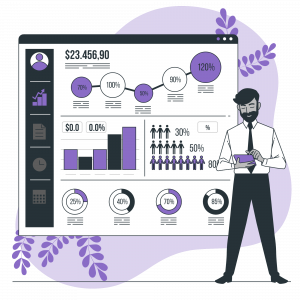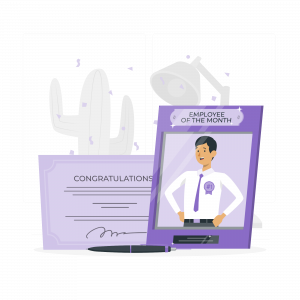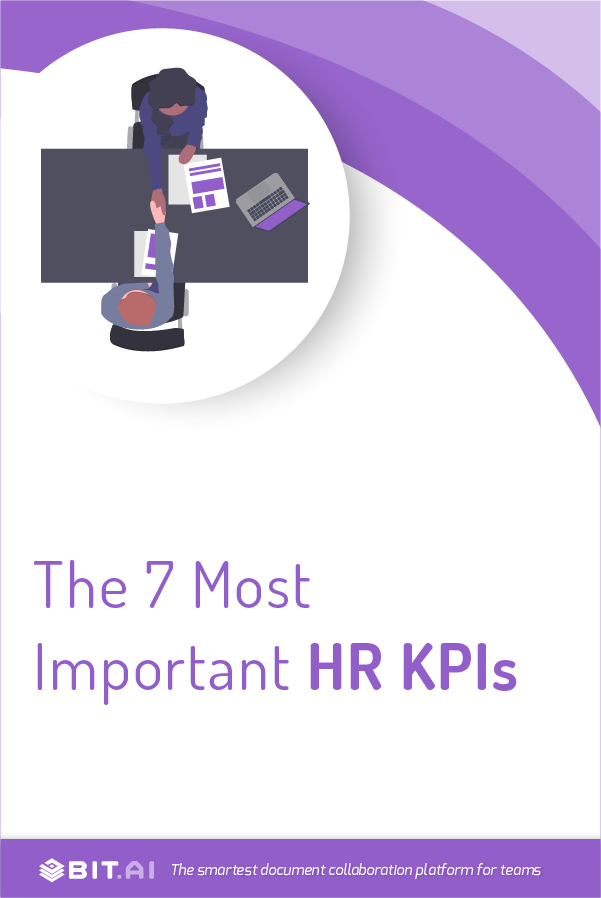What’s one of the greatest predictors of an organization’s success? The workforce! It is now, more than ever, important to hire and retain the right people in your company.
However, just hiring employees and talent isn’t enough. If you want to make the most out of your workforce, you need data. That simply means – you need to track HR KPIs!
Because if you don’t measure your performance, how’ll you know if you’re doing well? That’s why, in this blog, we will tell you about the 7 most important KPIs in Human Resources.
But first, let’s discuss what the term ‘HR KPI’ exactly means. Ready? Let’s go!
What Exactly is HR KPI?
Before we get to HR KPIs, let’s learn what a KPI is in the first place.
A KPI or Key Performance Indicator is a quantitative measure that can be used to evaluate how well your company is meeting its goals and objectives.
This doesn’t mean that everything you can measure is a KPI. Only metrics that resonate with your goals and strategies can be referred to as KPIs.

For example, in marketing departments, a marketer might use a newsletter’s open rate to measure the success of an email campaign. That would be a ‘marketing KPI’.
Whereas, in HR departments, the HR manager might use absenteeism rates to measure employee satisfaction. OR, they might measure employees’ productivity levels, as this can have an impact on the company.
…and that’s exactly what HR KPIs are – Human Resources Key Performance Indicators. HR KPIs are used to see how efficiently the human resources in your organization are contributing to your company’s objectives.
Now that you’re well familiar with the nitty-gritty of HR KPIs, let’s explore the top 7 HR KPIs that you may want to consider evaluating.
List of 7 Most Crucial HR KPIs You Need to Track:
1. The Employee Turnover
This HR KPI provides insights into how many of your employees leave, voluntarily or involuntarily. Basically, it indicates the success of your company in terms of retention.
You need to keep your turnover rate as low as possible because when an employee leaves, the HR department has to spend a lot of time and resources in finding a suitable replacement.
That’s not it. A high turnover even impacts your company’s productivity levels and hence, your bottom line. After all, the higher your staff turnover, the higher would be the costs!
So, if you have got a high turnover rate, you need to track its root cause and identify the problems that need to be fixed. The problems could be the salary, time off policies, work environment, etc.
To calculate your retention rate, you can compare the number of workers who joined the company in a year with those who stayed during the same period.
Read more: KPI Report: What it is & How to Create a Perfect One?
2. Rate of Absenteeism
According to studies, only 15 percent of employees are engaged in the workplace. And, we all know that workers with low interest and motivation are much more likely to call in sick or take leaves. 🙂
This is why you need to measure this HR KPI frequently! High absenteeism rates might have a negative impact on your company’s productivity levels, finances, and general well-being.
You can calculate the rate of absenteeism by considering how many hours your employees work on average. The results will reflect the level of motivation in your employees and how committed they are to their work.
If your find your absenteeism rate in the past couple of months is higher than usual, try to find out the reason, implement appropriate measures, and fix the situation.
3. Duration in the Position
Promotion is one of the things that motivates an employee. It’s human nature to grow, and your employees are no exception. According to a study, 35% of employees quit their job because of no pay raise in a year.
Basically, when employees feel that the company isn’t recognizing their efforts and they won’t be promoted anytime soon, they start looking for new opportunities outside the company.
So, if you want your employees to stick with the company, give them a chance to grow and promote them on time. A study shows that 40% of millennials expect a promotion in one to two years!
Tip: If you find that there are very few opportunities for growth in your company, discuss it with the management and try to come up with a solution.
4. Education & Training
The more trained your employees are, the better they will perform. Training equips your employees with the knowledge and expertise they need to fulfill their responsibility.
Not just that, it also gives your new hires a clear understanding of their roles and responsibilities. So, this HR KPI on our list can help boost the productivity levels of each employee in your company.

To evaluate this HR KPI, calculate how much you’ve invested in onboarding new hires as well as your current employees, and then track their skills and development.
You can even conduct a quick knowledge test and assess the scores to see if the training you provided was effective. Remember, better-trained employees can fuel your company’s growth!
5. Employee Productivity
This HR KPI measures the efficiency of your workforce. It analyses how much time does it take for your employees to accomplish their tasks and how well they perform these tasks.
Employee productivity is usually calculated by dividing the total sales by the number of employees. While measuring this KPI, consider all the facts that can impact your employees’ productivity levels.
This includes the time employees spend working at your company, their performance, the quantity of the product delivered, the quality, and more.
Yes, even though this is more of a manufacturing-oriented approach, you can certainly apply it to other areas. The results that you gather can help you create robust future office policies and adjust your ways of working.
6. Cost Per Hire
Talent acquisition is an incredibly important part of any company’s success because, without good employees, a company can’t be run. Investing in talents that will bring more value back – that’s always the bottom line.
This HR KPI majorly estimates the number of resources the company has invested into each employee. These expenses pile up rather quickly on a company’s budget, and that’s why this KPI shouldn’t be taken lightly.
‘Cost Per Hire’ covers the cost associated with advertising the position, reviewing and choose the candidate, conducting reviews, and everything else.
SHRM’s formula for cost per hire is – the sum of all recruiting costs divided by the number of hires in a particular time frame. In short, (total internal recruiting costs + external recruiting costs) / (total # of hires in a given time)
Read more: KPI Dashboard: Definition, Tools, and Tips!
7. Employee Satisfaction
Employee satisfaction isn’t just about financial perks. It’s a lot more than that. If you want to retain your employees, especially the highly sought-after specialists, measuring this HR KPI is inevitable.
For example, your employees might be more happy and content if they have a work-life balance, remote working options, a social corporate culture, and other such non-monetary benefits.

You should conduct employee satisfaction surveys on a regular basis and make sure that the needs of your employees are being met. If they have got any issues and concerns, you should address them immediately.
Don’t forget – you need a team that will help you achieve milestones, and only satisfied team members can put their best foot forward.
8. Overtime Hours
Overtime hours refer to the hours an employee works beyond their normally scheduled working hours. This HR KPI can help you determine an employees’ workload.
Most employees aren’t thrilled by the idea of overtime. High workload and working overtime can significantly lower the employees’ motivation and dedication, which could lead to an increase in absenteeism rate!
See, an employee might be working overtime for a lot of reasons, such as a higher volume of orders or short-handed staff. Whatever the reason is, you need to figure out a solution.
Lastly, plan your projects properly. With a solid plan in hand, you can finish your project much faster and with fewer unpleasant surprises – like overtime hours.
Our team at bit.ai has created a few awesome templates to make your hr process more efficient. Make sure to check them out before you go, your hr team might need them!
- Employee Handbook Template
- Transition Plan Template
- Job Description Template
- Offer Letter Template
- Talent Acquisition Template
- Performance Improvement Plan Template
- Meeting Agenda Template
- Process Documentation Template
- SMART Goals Template
- Checklist Template
Wrapping Up
An American statistician once said, “without data, you’re just another person with an opinion.”
That’s why HR KPIs are so important! You can extract valuable insights from these KPIs, which would facilitate better decision-making and problem-solving.
Moreover, you can use HR KPIs to optimize your recruiting processes, increase employee engagement, lower the turnover rates, improve the training costs…the benefits are endless.
Before we bid adieu, here’s something you need to remember: only focus on the essential HR KPIs. Don’t try to measure everything. They are known as KEY performance indicators for a reason.
Further reads:
12 Marketing KPIs Every Marketing Team Should Monitor!
Succession Planning: What is it & How to do it?
9 Best Payroll Software For Every Business! (Free & Paid)
How to Ace the New Hire Onboarding Process?
Top Employee Management Systems You Should Be Using in 2022
Conversion Rate: What is it & How to Improve it?
12 Sales KPIs Your Sales Department Should Measure!
10 Top Performing Business Metrics Your Business Must Know About!



